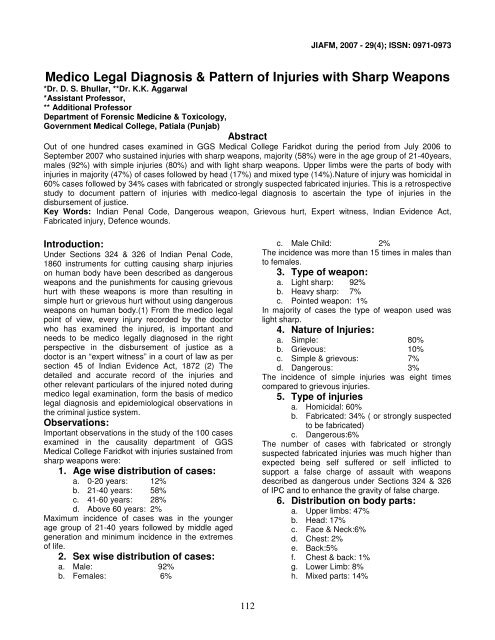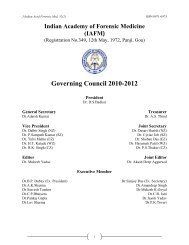Download - forensic medicine
Download - forensic medicine
Download - forensic medicine
You also want an ePaper? Increase the reach of your titles
YUMPU automatically turns print PDFs into web optimized ePapers that Google loves.
JIAFM, 2007 - 29(4); ISSN: 0971-0973<br />
Medico Legal Diagnosis & Pattern of Injuries with Sharp Weapons<br />
*Dr. D. S. Bhullar, **Dr. K.K. Aggarwal<br />
*Assistant Professor,<br />
** Additional Professor<br />
Department of Forensic Medicine & Toxicology,<br />
Government Medical College, Patiala (Punjab)<br />
Abstract<br />
Out of one hundred cases examined in GGS Medical College Faridkot during the period from July 2006 to<br />
September 2007 who sustained injuries with sharp weapons, majority (58%) were in the age group of 21-40years,<br />
males (92%) with simple injuries (80%) and with light sharp weapons. Upper limbs were the parts of body with<br />
injuries in majority (47%) of cases followed by head (17%) and mixed type (14%).Nature of injury was homicidal in<br />
60% cases followed by 34% cases with fabricated or strongly suspected fabricated injuries. This is a retrospective<br />
study to document pattern of injuries with medico-legal diagnosis to ascertain the type of injuries in the<br />
disbursement of justice.<br />
Key Words: Indian Penal Code, Dangerous weapon, Grievous hurt, Expert witness, Indian Evidence Act,<br />
Fabricated injury, Defence wounds.<br />
Introduction:<br />
Under Sections 324 & 326 of Indian Penal Code,<br />
1860 instruments for cutting causing sharp injuries<br />
on human body have been described as dangerous<br />
weapons and the punishments for causing grievous<br />
hurt with these weapons is more than resulting in<br />
simple hurt or grievous hurt without using dangerous<br />
weapons on human body.(1) From the medico legal<br />
point of view, every injury recorded by the doctor<br />
who has examined the injured, is important and<br />
needs to be medico legally diagnosed in the right<br />
perspective in the disbursement of justice as a<br />
doctor is an “expert witness” in a court of law as per<br />
section 45 of Indian Evidence Act, 1872 (2) The<br />
detailed and accurate record of the injuries and<br />
other relevant particulars of the injured noted during<br />
medico legal examination, form the basis of medico<br />
legal diagnosis and epidemiological observations in<br />
the criminal justice system.<br />
Observations:<br />
Important observations in the study of the 100 cases<br />
examined in the causality department of GGS<br />
Medical College Faridkot with injuries sustained from<br />
sharp weapons were:<br />
1. Age wise distribution of cases:<br />
a. 0-20 years: 12%<br />
b. 21-40 years: 58%<br />
c. 41-60 years: 28%<br />
d. Above 60 years: 2%<br />
Maximum incidence of cases was in the younger<br />
age group of 21-40 years followed by middle aged<br />
generation and minimum incidence in the extremes<br />
of life.<br />
2. Sex wise distribution of cases:<br />
a. Male: 92%<br />
b. Females: 6%<br />
c. Male Child: 2%<br />
The incidence was more than 15 times in males than<br />
to females.<br />
3. Type of weapon:<br />
a. Light sharp: 92%<br />
b. Heavy sharp: 7%<br />
c. Pointed weapon: 1%<br />
In majority of cases the type of weapon used was<br />
light sharp.<br />
4. Nature of Injuries:<br />
a. Simple: 80%<br />
b. Grievous: 10%<br />
c. Simple & grievous: 7%<br />
d. Dangerous: 3%<br />
The incidence of simple injuries was eight times<br />
compared to grievous injuries.<br />
5. Type of injuries<br />
a. Homicidal: 60%<br />
b. Fabricated: 34% ( or strongly suspected<br />
to be fabricated)<br />
c. Dangerous:6%<br />
The number of cases with fabricated or strongly<br />
suspected fabricated injuries was much higher than<br />
expected being self suffered or self inflicted to<br />
support a false charge of assault with weapons<br />
described as dangerous under Sections 324 & 326<br />
of IPC and to enhance the gravity of false charge.<br />
6. Distribution on body parts:<br />
a. Upper limbs: 47%<br />
b. Head: 17%<br />
c. Face & Neck:6%<br />
d. Chest: 2%<br />
e. Back:5%<br />
f. Chest & back: 1%<br />
g. Lower Limb: 8%<br />
h. Mixed parts: 14%<br />
112




![syllabus in forensic medicine for m.b.b.s. students in india [pdf]](https://img.yumpu.com/48405011/1/190x245/syllabus-in-forensic-medicine-for-mbbs-students-in-india-pdf.jpg?quality=85)



![SPOTTING IN FORENSIC MEDICINE [pdf]](https://img.yumpu.com/45856557/1/190x245/spotting-in-forensic-medicine-pdf.jpg?quality=85)

![JAFM-33-2, April-June, 2011 [PDF] - forensic medicine](https://img.yumpu.com/43461356/1/190x245/jafm-33-2-april-june-2011-pdf-forensic-medicine.jpg?quality=85)



![JIAFM-33-4, October-December, 2011 [PDF] - forensic medicine](https://img.yumpu.com/31013278/1/190x245/jiafm-33-4-october-december-2011-pdf-forensic-medicine.jpg?quality=85)

